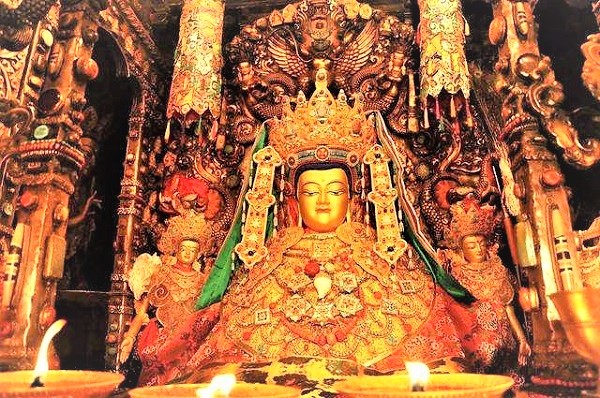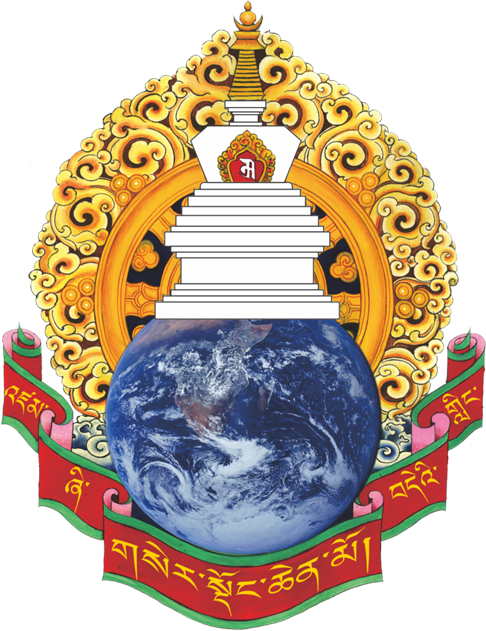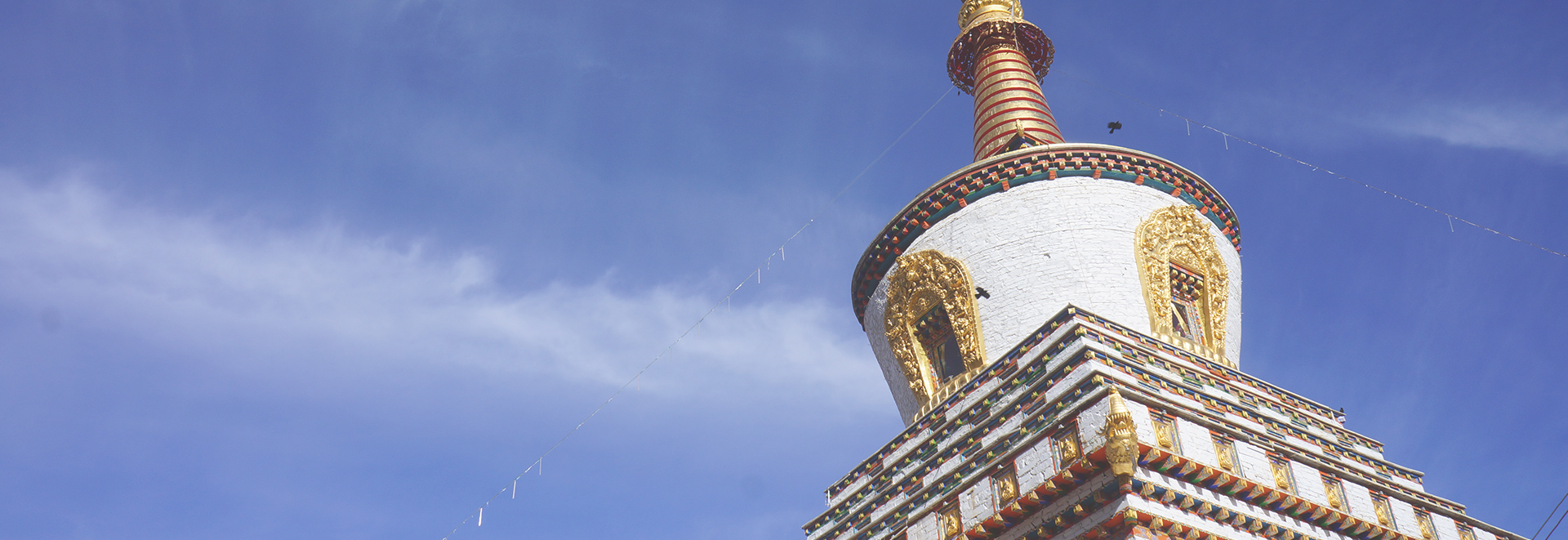Longsal Nyingpo Lineage
LINEAGE

Shākyamuni Buddha Buddha, the Fully Awakened One, was born amid wondrous signs over twenty-five centuries ago, in the Lumbinī garden, now in Nepal, to King Shuddhodana and Queen Māyādevī of the Shākya lineage. He was named Siddhārtha, and he soon became versed in various kinds of knowledge and skilled in different arts in order to become the future ruler of his kingdom. In time, his consort Princess Yashodharā conceived their son, Prince Rāhula.
Prince Siddhārtha lived amid the supreme enjoyments of worldly pleasures and luxuries that could be provided in his time. His father even tried to prevent him from seeing or learning about people’s miseries. But Siddhārtha realized that in this mundane world no one has any true joy and there is nothing but suffering, the overwhelming suffering of old age, sickness, death, and endless woes. Whatever is born ends in death, whatever is brought together ends in separation, and whatever is full of joy ends in pain. All the mundane activities, directly or indirectly, cause only suffering of dissatisfaction. All these sufferings are rooted in the wrong mental approach of grasping at “self,” burning with negative emotions of hatred and desire, and craving for painful joy, as when yearning for the sensation of scratching an itch. Siddhārtha was determined to find the way to freedom from the life cycle of suffering and to lead others, the mother beings, to the realization of freedom and enlightenment.
When he was twenty-nine, after his father reluctantly gave him permission to renounce his mundane life, he became a homeless ascetic wanderer. He went to a number of famous sages of India and meditated according to their teachings. He contemplated while observing severe austerities for six years on the banks of the Nairajñanā River. These pursuits generated high stages of absorption, peace, and joy, but none led him to the ultimate goal he was seeking: total freedom from grasping at self, for all those attainments retained some degree of residue of grasping at self.
At the age of thirty-five, after realizing that physical austerity was not an effective means of reaching the truth, Siddhārtha drank some refined milk. Having nourished himself, he went to Vajrāsana, now known as Bodhgayā in the state of Bihar, India. There, on the eve of the full moon of the Vaishākha month (April/May), he sat in the meditation posture beneath a pipal (ashvattha) tree (known since then as the Bodhi Tree) and entered into absorption.
After dusk, demonic forces massed before him with threats and temptations to prevent him from entering enlightenment. Clouds of demonic forces thundering threats and raining of weapons appeared. Celestial virgins came dancing to him to arouse his senses. But none moved his mind, and he remained in the contemplation of lovingkindness. The rain of weapons became the rain of flowers, and all the apparitions faded away like a mirage.
Then, in the early part of the night, he entered into the four stages of absorption (bSam gTan bZhi). The first stage is a one-pointed absorption with joy (dGa’) and bliss (bDe), detached from the sensations of the desire realm, reached by thinking about (rTog) and analyzing (dPyod) those sensations as gross and negative. The second stage is a one-pointed absorption in clear mind with joy and bliss, detached from thoughts and analysis of the sensations as in the first stage. The third is a one-pointed absorption with bliss, detached from taking joy in the sensations as in the second stage through equanimity (evenness), recollection, and awareness. The fourth is a one-pointed absorption with equanimity, detached from the feelings of bliss of the third stage by seeing it as too gross by means of pure mindfulness.
Then, with that total calm, collected, luminous, applicable, and clear mind created by the four stages of absorption, he focused on developing the three states of awareness (Rig Pa gSum). (1) He acquired the “awareness of realizing the wisdom with divine eyes” which sees the infinite details of the vicissitudes of all beings with their karma, the cause behind them. (2) He acquired the “awareness of realizing the wisdom of past lives,” which sees infinite numbers of past lives of oneself and others and their various happenings and experiences in complete detail. (3) Then, in the early part of the fullmoon day, he acquired the “awareness of realizing the wisdom of exhausting the contamination” by thinking about and realizing the nature of the “twelve-links of interdependent causation” (rTen ’Brel bChu gNyis), the law of life.
In this stage, he realized that because of (1) ignorance (unenlightenment) there arises the (2) formation of karma (volitional action), because of the formation arises (3) consciousness, because of consciousness arise (4) designation and form (mental and physical objective phenomena), because of designation and form arise the (5) six sense faculties, because of the sense faculties arises (6) contact (of objects, senses, and their application), because of contact arises (7) sensation, because of sensation arises (8) craving, because of craving arises (9) clinging, because of clinging arises (10) becoming [existence], and because of becoming arise (11) birth, sickness, (12) aging, pain, and death. Then also he realized the law of the reversed process of the twelve-link interdependent causation. Because of the cessation of ignorance formation ceases, and so on.
He realized the four noble truths (’Phags Pa’i bDen Pa bZhi) of each twelve-link interdependent causation. He saw what is ignorance, what is the cause of ignorance, what is the cessation of ignorance, and what is the path of the cessation of ignorance, and so on.
He realized the four noble truths. (1) He realized the truth of suffering, that the whole of mundane existence in its totality is nothing but a cycle of suffering. (2) He realized the truth of the cause of suffering, the karma with emotional forces rooted in craving and grasping at self. (3) He realized the truth of the cessation of suffering, the attainment of nirvāṇa, enlightenment. (4) He realized the truth of the path of the cessation of suffering, the training in the eightfold noble path, namely right view, right thought, right speech, right action, right livelihood, right effort, right mindfulness, and right concentration.
Then, in the early dawn, he entered a vajralike absorption, solid, as no obstruction can destroy it; stable, as it cannot be moved by concepts; of the nature of oneness, as all things are of one taste in it; and all-pervading, as it is the true nature of all existents. In a single instant he exhausted even the most subtle traces of obscurations that he had harbored in himself, perfected the realization of the three states of awareness, and became the fully enlightened one, the Buddha. He leaped into the air to a height of seven tal (palm) trees and, sitting there, proclaimed:
Today, all the rebirths [for me] have ceased.
The path is completed.
There is nothing more to pursue.
And:
I have realized an ambrosia-like Dharma.
It is a clear light: uncreated, profound, peaceful, and free from elaborations.
During the remaining forty-five years of his life, tirelessly traveling on foot and living on alms of one meal a day, with love and wisdom Buddha taught the way to Buddhahood and served his saṅgha, the community of monks, nuns, and devotees and all those whom he met and who came to him. During that period, the Buddha taught various paths for people of different temperaments.
According to the Mahāyāna and Vajrayāna traditions of Buddhism, Buddha taught not only Hīnayāna, the common or orthodox Buddhism, but also Mahāyāna, advanced Buddhism, and Vajrayāna, esoteric Buddhism.
Hīnayāna (or Theravādin) teachings of the Buddha are known as the Tripiṭaka, the three baskets. They are the Vinaya, on the moral discipline of the monastic community and lay devotees; Abhidharma, on the wisdom of Buddhist psychology and metaphysics; and Sūtra, on contemplations and various discourses.
His first sermon was on the four noble truths. It explains the whole evolution of the mental and physical cycle of the mundane world and the cycle in reverse. He taught it to his first five monk-disciples at the Deer Park, now known as Sārnāth, near Vārāṇasī in India. The Buddha said:
O monks, there are four noble truths. They are suffering, the cause of suffering, the cessation of suffering, and the path of the cessation of suffering. (1) What is the noble truth of suffering? It is the suffering of birth, old age, sickness, death, separation from desirable things, facing the unwanted, and not getting what one is seeking. In short, the five aggregates of attachment are suffering. This is called suffering. (2) What is the noble truth of the cause of suffering? It is the craving [which produces] re-existence (or re-becoming as beings) and which is accompanied by passionate desire, and which finds total delight in [or attachment to] this and that. This is called the cause of suffering. (3) What is the noble truth of the cessation of suffering? The cessation of suffering is the total cessation of and total freedom from the desire, the craving, which produces re-existence and which is accompanied by passionate desire, and which finds, creates, and takes total delight in this and that. (4) What is the path that leads to the cessation of suffering? It is the noble eightfold path, which consists of right view, right thought, right speech, right action, right livelihood, right effort, right mindfulness, and right concentration.
The achievement of the fruits of Buddhism is dependent on the efforts of the individual practitioners themselves, and the Buddha’s part is only to teach and inspire them. The Buddha said:
I have shown you the path of liberation.
You should understand that your liberation depends on yourself.
The essence of Buddhist training is to act only with the proper discipline and to tame one’s own mind through the eightfold noble path. The Buddha said:
Commit no evil deeds. Perform all the virtuous deeds.
Tame your own mind. That is the Buddha’s teaching.
If we could tame our mind, all our physical actions would naturally become well disciplined, for the mind leads all. Buddha said:
Mind is the main factor, and it leads all the actions.
With a pure mind, whatever you say or do
Will cause only happiness.
It is like a shadow that follows.
When we understand and realize the truth of life and nature with our mind, we will attain freedom from all the sufferings. The Buddha said:
When you see with your wisdom that all the compound things
Are impermanent, . . . suffering . . . [and] selflessness, . . .
You will never be hurt by any suffering.
That is the right path!
For Mahāyāna disciples, both human and nonhuman beings, the Buddha delivered the Mahāyāna teachings such as “transcendental wisdom” and “Buddha essence” on Mount Gṛidhrakūṭa (Vulture Peak) in Rajgir (Rājagṛiha) in India and in many other places. Mahāyāna teachings were given to limited audiences, for the time of Mahāyāna teachings was not yet ripe. Centuries later, they were revealed to the public by masters who were keeping them and also by many who brought them back from different lands and world systems.
Most of the Mahāyāna disciplines are based on Hīnayāna, or common Buddhist teachings, but the attitude and view are different. Compassion is an important practice in common Buddhism also, but the intention to take total responsibility for others or to remain until every mother being is liberated is called bodhichitta, the mind of enlightenment. To train in the six perfections with that bodhichitta is the unique approach of Mahāyāna.
In respect to view, the concept of emptiness is the central core of Mahāyāna doctrine. In absolute meaning or ultimate truth all phenomena are emptiness, and on the relative level or in conventional truth all are arising through interdependent causation, like a dream, mirage, or reflection. Thus the two truths are in union, and they are the nature of everything, with no contradictions. Emptiness is not a negative or nil, but it is total openness and freedom from dualistic mentality, conceptual designations, and notions of any extremes, either of existence or nonexistence, neither or both. Primordial wisdom, which is emptiness and the realization of emptiness, clearly sees everything simultaneously without any limits. This wisdom is also symbolized as the mother, the source or dwelling place of all the Buddhas.
In respect to training, the followers of Mahāyāna first employ their mundane mind and mental events as the means of attaining Buddhahood, and by progressing through that process, they finally attain Buddhahood. The Buddha said:
Those bodhisattvas who have attained the wisdom of realizing the [union of] interdependent arising and the unborn and unceasing [nature of emptiness],
Like the rays of the unclouded sun dispelling the darkness,
Destroy the ignorance and attain the naturally present
[Buddhahood].
And:
I bow to the great mother of the Buddhas of the three times,
[The emptiness, which is] the domain of self-awareness wisdom,
Freedom from designations, thoughts, and expressions,
And, unborn and unceasing, like space.
And:
Form is emptiness. Emptiness is form.
Emptiness is not separate from form.
Form is not separate from emptiness.
To Vajrayāna disciples, the exceptionally matured human and nonhuman audience, the Buddha gave the empowerments or initiation (abhiṣheka) and teachings of tantras, the esoteric teaching of Guhyasamāja and Kālachakra and so on at Dhānyakaṭaka in Oḍḍiyāṇa, and other places, by transforming himself into the Sambhogakāya form, the true Buddha manifestation. Centuries later, when the time had come, those teachings were brought back from different lands and revealed to the public. In addition, many tantras were revealed by the Buddha(s) to numerous great realized adepts.
The teachings of tantra are not just teachings but also convey a transmission of the esoteric power, the realization of primordial wisdom. This transmission takes place during the empowerment of the disciple into the learning and realization of tantra. Then the disciple maintains the continuity of that transmission, and that is called observing the samaya, the esoteric vow. With unbroken samaya, the disciple trains in the two stages. The development stage cleanses attachment to phenomena, body, and mind. In it, with mental efforts, one visualizes the world, body, and mind as the maṇḍala of the deity, appearing but empty, in order to purify birth, death, and the intermediate state. The perfection stage fulfills the attainments of power, blessing, and realization. In it, by admitting the air/energy and mind into the central channel, one realizes and perfects the wisdom, which is innate presence, free from thoughts and all-pervading. Tantric trainings embody an extraordinary skill of perfecting. For example, they perfect one’s mind as the union of the realization of emptiness and the arising of all as the wisdom of great bliss (or compassion) and as the three Buddha bodies. Tantric training brings about the attainment of Buddhahood in this very lifetime. The Buddha said:
The teachings of the vajra-holder [trantra]
Are based on the two stages.
They are the development stage
And the perfection stage.
And:
The inseparability [union] of emptiness and compassion
Is called the Enlightened Mind.
At the age of eighty, on the full-moon day of the Vaishākha month (April/May), sitting beneath shāla (Shorea robusta) trees at Kushinagara in northern India, the Buddha proclaimed to his followers:
Monks, I am about to enter into nirvāṇa. Don’t torment yourselves by sorrow over it. If you have any question, ask me, so that no one will have to feel remorse over missing such an opportunity.
He repeated this three times, but all kept silent. Then the Buddha took off his upper robes and, showing his bare golden chest, repeatedly asked the audience to see the body of the Buddha, which is rare to witness. All felt the peace of an absorption by watching, without blinking, the purified goldlike body of the Buddha. Then once again he put on the robes, and, lying on his right side, he entered into mahāparinirvāṇa, the great cessation of sorrow, the ultimate peace, Buddhahood. He left his body as the source of blessing and recollection of the teachings and the presence of the Buddha.
*Above Contents from Masters of Meditation and Miracles: Lives of the Great Buddhist Masters of India and Tibet by Tulku Thondup (1999).


